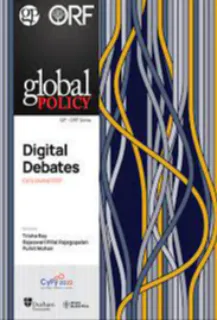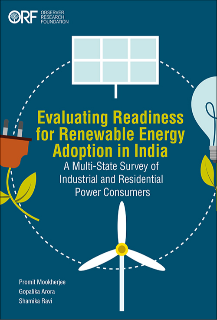Editors’ Note
That the word of the year for 2021 was “vaccine” was hardly surprising. The development of the COVID-19 vaccine happened in record time, demonstrating sheer human will and ingenuity. At the same time, as the wealthier nations hoarded supplies and poorer countries were left adrift, we were reminded of the importance of self-reliance, even as the world has become more connected than ever in history.
Technology competition and rivalry is at the heart of this flux, whether in the Indo-Pacific, the Atlantic, or beyond. There are a number of factors contributing to it, and growing risks and challenges from emerging and critical technologies are overlaid upon the inherent complexities present in these regions. Vikram Sharma’s essay for this edition of Digital Debates highlights one such paradigm-breaking development, that of quantum technologies, and its implications for cybersecurity given the advances in scale, speed, and processing power. Nicolo Andreula and Stefania Petruzzelli, in their piece, cite the many reasons we should be worried about the metaverse, where power can transcend the limits of space and perception. Michael Depp’s essay, for its part, interrogates the potential of AI to disrupt the international balance of power.
The US-China tech rivalry is another important factor contributing to the uncertainty. China’s efforts to overtake the US to become the global technology leader has prompted successive US administrations to enact measures to ensure their country’s dominance in these domains. However, China will not be able to gain proficiency in many of the critical and emerging technologies without sourcing components from the US and its allies. As the US National Strategy for Critical and Emerging Technologies (2020) states, it is Beijing’s “targeting sources of United States and allied strength by employing means that include stealing technology, coercing companies to disclose intellectual property, undercutting free and fair markets, failing to provide reciprocal access in research and development (R&D) projects, and promoting authoritarian practices that run counter to democratic values” that have made the US come up with more stringent measures to counter China and Russia.[1]
As the world is broken into camps, countries are turning to likeminded partnerships. Tobias Scholz writes about the resurgent Quad—the “democratic diamond” comprising Australia, India, Japan, and the United States—unified by their view of China as a geopolitical, if not existential, threat to their own states. This grouping, perhaps unlikely given their vastly different political systems, histories, and peoples, has a real opportunity to “shape norms, standards, and institutional mechanisms as well as strategic imperatives for the digital Indo-Pacific in the decades to come.”
Also under the scanner are China’s efforts at deploying these new and critical technologies for military use in order to make the People’s Liberation Army (PLA) a more effective fighting force, as well as Russia’s use of legitimate and illegitimate ways to target the US technologies. The more conventional security arenas such as nuclear and space security are also witnessing fierce competition and rivalry, the most evident of which is the new momentum to develop a range of counterspace capabilities. As space security dynamics intensifies and outer space becomes an extension of terrestrial geopolitics, outer space politics is becoming more complicated in various ways.
For one, several countries other than the US, China and Russia are developing counterspace capabilities, with many more establishing dedicated military space institutions, albeit some merely for coordination purposes. China’s PLA Strategic Support Force, for example—which controls space, cyber and electronic warfare—is a much more potent force than India’s Defence Space Agency. Unless we are able to earnestly kickstart multilateral discussions, gradually leading to binding global instruments, it is unlikely that we will have uninterrupted, safe and secure access to space. One effort underway is the UN-mandated Open-Ended Working Group (OEWG) tasked to develop norms of behaviour that will address current and emerging space security threats. In her essay, Laetitia Zarkan gives an account of the two sessions of the OEWG held so far, giving the reader a sense of how the discussions are progressing and the likelihood of a consensus at the end of the group’s four sessions. For his part, Daniel Porras, in his chapter addresses one counterspace capability that is inherently destabilising—i.e. ASAT weapons. He makes a case for halting the current trend regarding these weapons. Given that the usable orbits in space are limited in nature and ASATs produce large amounts of debris, this is an important issue on which a consensus is overdue. This is of course a subject of the ongoing OEWG and there could be some temporary steps to limit these tests, before more binding measures are formalised.
The salience of nuclear weapons in national security strategies is also growing, which involves modernisation of weapons in both quantitative and qualitative terms. Ruhee Neog in her essay looks at the nuclear dynamics in South Asia, where both politics and technology are important in possibly altering the calculations of India, Pakistan, and China. While nuclear weapons are seen as political tools by these three countries, the relevant query is how they interface with emerging and critical technologies to produce more risks—and this is a focus of Ruhee’s essay. Tanvi Kulkarni then takes a close look at the disruptive aspects of emerging and critical technologies and why they tend to threaten strategic stability. Given the destabilising and risk-inducing nature of these technologies, this essay makes a case for strengthened dialogue processes and risk reduction measures as important steps moving forward.
It is evident, however, that the relevance and impact of emerging and critical technologies cannot be seen from a security prism alone. The challenge is in terms of finding the right balance between creativity and intellectual property on one side, and a global system that provides for open and mutual exchange of ideas, capital, and services. This tension between the traditional, open, globalised system and increased protective measures will continue until a certain degree of balance in power dynamics is achieved.
What is even more problematic is that the efforts at developing global rules-of-the-road have fallen victim to great-power contestations, resulting in deadlocks around global governance. Furthermore, with high-level norms being interpreted in practice in divergent ways, Husan Chahal asks, for instance, in relation to AI: “If the ultimate goal is the ethical development and deployment of AI, are efforts towards codifying and devising high-level ethical AI principles even a fruitful exercise?” Additionally, as the contributors to this volume find, some of the older critical technologies such as nuclear and outer space have been governed by rules that were framed in the 1960s and 1970s, and they are clearly showing signs of age. Recent efforts to frame new rules, and political and legal instruments, have not borne results.
Technology has brought in enormous benefits and transformed human lives—from efficient transport systems to gaining greater and safer access to medical services, education, and food as well as digitalisation technologies that have accelerated productivity and competence in many sectors. Sachin Malhan, Smita Gupta and Saurabh Karn, in their piece, see promise in the use of AI to improve access to justice, strengthening the capacity of courts and enabling the more efficient resolution of cases.
With data-intensive technology touching every aspect of our lives, Basu Chandola’s essay highlights India’s experience developing a data governance framework, citing the country’s attempt to strike a balance between data protection—on the grounds of economic growth—on one hand, and data sharing and empowerment, on the other. Viktoria Nagy’s chapter brings out another point of tension. She examines technology-based interventions in humanitarian assistance, and how the desire for “efficiency” has contributed to the wholesale exclusion and surveillance of refugees and migrants.
And with this, Digital Debates comes full circle to power. The way technologies are used is an expression of power, as Viktoria Nagy’s critique so clearly demonstrates. The ability to set the terms by which nations are able to engage with rules, and the choices they make about partners, are a form of power. Indeed, the very act of developing technologies is a manifestation of power as well. Gabriella Skoff and Stuart Rollo’s philosophical reflection on quantum includes this stark statement: “It is a society which forms great concentrations of material and technical wealth and concentrates political power in such a way as to direct the use of this wealth towards speculative technological ends. It is clear that under current conditions the power of quantum computing will be far more centralised and controlled than is the computing of today.”
As it is with CyFy 2022, the conference we host parallel to the release of this edition of Digital Debates, these 13 essays capture the milieu of anxieties, hopes, and questions about our relationship with technology—as individuals, nations, and a global community.
Read the journal here.
[1] The White House, National Strategy for Critical and Emerging Technologies, October 2020,
The views expressed above belong to the author(s). ORF research and analyses now available on Telegram! Click here to access our curated content — blogs, longforms and interviews.

 PDF Download
PDF Download



 PREV
PREV




